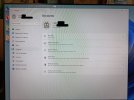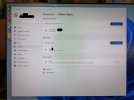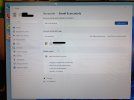Well, today has added a new wrinkle in this, and a frustrating one. The first two machines I set up used a
personal MS Account that linked to the OOBE Windows user account that was set up. On both of those machines we just enabled SMB1 and, instantly and automagically, the server was seen and we simply had to enter the login credentials (and check the box to remember them) and, voilà, the network drive was mapped to the server and has stayed that way for two weeks and one week, respectively.
It's also important to note that this was one of those cases where a single email address had been associated both with the personal and business MS accounts, and the business account is tied to GoDaddy. Part of today's work was finally, and completely separating that email address from the personal account. It's now associated strictly with the business account. The personal account now uses a freshly created outlook.com address.
The machine today was set up going in the "work or school account" direction rather than the personal account direction. This is probably what is at the root of the major problem: I can't get this machine to talk to the Windows Server 2003 machine. It can be seen on the network, but there is no way to log in to it. If you try it always wants you to enter a PIN (by default) for the MS-Account to log in to the server, but there is no way to make that work. You can't even create an account under 2003 that includes an at sign in the name. If I try the "other options" the options I'm presented with do NOT include one for a straight username and password for the server side, it's always demanding an email address and password. There apparently once was an option for just username and password (and that's what I was asked for on the other two machines) but it's not showing up now.
I suspect this is because Azure AD has entered the picture, which it had not on the other machine. SMB1 is enabled on this new machine that was set up with the business account. Here are three screenshots that I hope might help shed some light:



Note well that second shot, which shows "Other Users." On all of these machines I have been setting up a local account which is the one which will be used day to day. This one was no different. What is different is that the other "Chris" user is never presented on the login screen, and what is there is "Other User" (literally) which you can't do anything with.
If I need to N&P this machine, and start from scratch using the personal account that's what I'll do, but I'd like to avoid that if possible. I'd also love to know why this inability to actually connect to the server even exists.
I am also asking, respectfully, for no lectures about why I should not use SMB1. I am well aware that it's "not ideal," to put it mildly, but it's what I must work with for the moment. Getting it out of the picture is phase 2, which will come, but at this point in time it's got to be made to work. If it's not a solution to the issue, or an explanation of what's going on even if there is no fix, I really don't need or want to hear it. This is a situation that can be solved, and the focus should be on the how, not meta-analysis of why we should not be doing this in the first place. It is what it is for the time being.



